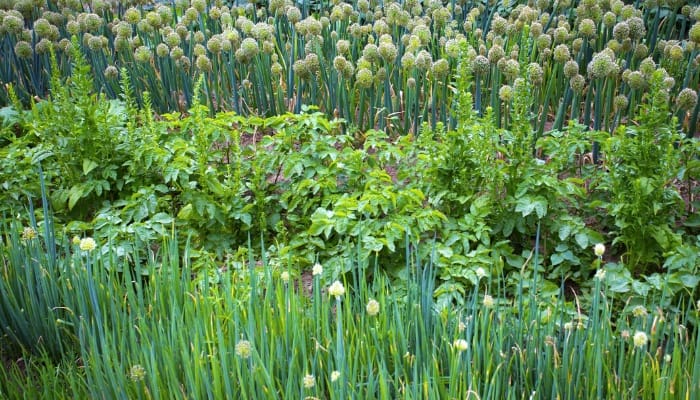Trap cropping is a method used to divert or sway harmful pests to feed on one particular plant instead of another, similar to using a fake target to deceive them.
In many cases, a trap crop is another vegetable or flower that simply attracts the insects away from the main crop the gardener wants to keep pest-free.
Trap cropping is one great tool in the arsenal of integrated pest management strategies.
- 32 Common Trap Crops To Protect Your Plants
- 1. Alfalfa
- 2. Amaranth
- 3. Basil
- 4. Blue Hubbard Squash
- 5. Brassicas
- 6. Buckwheat
- 7. Calendula
- 8. Cherry Hot Peppers
- 9. Chervil
- 10. Corn
- 11. Cucurbits
- 12. Dill
- 13. Four O’Clocks
- 14. Horseradish
- 15. Legumes
- 16. Marigold
- 17. Medick
- 18. Millet
- 19. Mustard Plants
- 20. Napier Grass
- 21. Nasturtiums
- 22. Okra
- 23. Onions & Garlic
- 24. Parsley
- 25. Radishes
- 26. Sorghum
- 27. Soybeans
- 28. Stinging Nettles
- 29. Sunflowers
- 30. Tansy
- 31. Tomato
- 32. Zinnia
- Benefits of Trap Cropping
- How To Use Trap Crops for Pest Control
- Considerations Before Planting Trap Crops
- Options for Killing Pests Once on Trap Crops
32 Common Trap Crops To Protect Your Plants
So many plants we grow are naturally a pest’s favorite meal. Plant a variety you know will attract the damaging insect pests to keep them from damaging the crop you are trying to protect.
See below how some of our favorite plants can do more than provide food or beauty in the garden!
1. Alfalfa
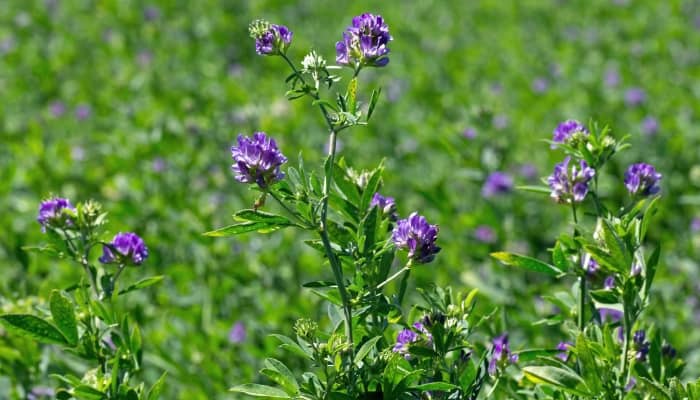
While it is actually a part of the legume family, alfalfa is commonly referred to as an herb for its nutty, slight sweetness, and mild green flavor.
Commonly consumed as sprouts, it will grow to be about 3 to 4 feet tall, so be sure to plant it so it won’t shade out your other crops.
- Pest Targeted: Lygus bugs
- Used To Protect: Cotton
- Where To Plant: Strip intercrop
2. Amaranth

Grown specifically for its seeds that cook similarly to quinoa, amaranth can be a monster in the garden!
Be sure to choose a variety that is small and only grows to be 1 to 2 feet tall because many varieties average 8 feet tall!
- Pests Targeted: Cucumber beetles, aphids, leafminers, beet webworms
- Used To Protect: Cucumbers
- Where To Plant: Border rows
3. Basil

Who doesn’t love fresh basil? But did you know that it is more than just a delicious herb? Basil is just as loved by insects as it is by humans for its sweet essential oils.
These fragrant oils can also repel pests. Plant it in your garden for fresh leaves when you want and for 24/7 insect control as well!
- Pest Targeted: Thrips
- Used To Protect: Garlic
- Where To Plant: Border rows, intercrop
4. Blue Hubbard Squash

A true sacrificial plant, blue hubbard squash plants will grow edible squash but also be a magnet for the destructive beetles that ruin squash crops regularly.
Plant it as a border or perimeter for a line of defense. All the pests will stop there before moving to your main crop.
- Pests Targeted: Cucumber beetles, squash bugs, and squash vine borers
- Used To Protect: Cucumber, zucchini
- Where To Plant: Border rows
5. Brassicas

Brassicas include broccoli, cauliflower, kale, and mustard — odds are you’ll have a few of these growing in your garden already!
Regularly spraying these with B.T. (Bacillus thuringensis) is a great defense against the most common caterpillars.
- Pests Targeted: Aphids, cabbage moths, caterpillars
- Used To Protect: Other brassicas
- Where To Plant: Intercrop
6. Buckwheat

A great trap crop and cover crop, this is a must-plant! It grows thickly, so it will outcompete weeds, and it can be tilled into the soil after flowering to release plentiful phosphorus back into the soil.
It is also an excellent beneficial insect attractant and thrip catcher.
- Pest Targeted: Thrips
- Used To Protect: Vegetables, ornamentals
- Where To Plant: Border rows
7. Calendula

Renowned for its healing properties, it can also help kill pests with ease! It is a lovely flower to plant in your garden that will attract beneficial insects and stop a few of the worst garden offenders.
- Pests Targeted: Aphids, whiteflies, thrips
- Used To Protect: Vegetables, ornamentals
- Where To Plant: Border rows
8. Cherry Hot Peppers

Pepper maggots love cherry hot peppers, so planting them will help keep your bell peppers free of holes!
Plant them as a border row, and once the pests accumulate, spray only the border with your pesticide to limit the killing of beneficial insects and reduce your pest population.
- Pest Targeted: Pepper maggots
- Used To Protect: Bell peppers
- Where To Plant: Border rows
9. Chervil

Closely related to parsley, you may know chervil as French parsley. Its curly leaves and essential oils create a trap for the insects by attracting them but not allowing them to leave.
This is a great long-term perennial herb for insect control and cooking!
- Pests Targeted: Slugs, aphids, carrot rust flies
- Used To Protect: Vegetables and other ornamentals
- Where To Plant: Among the crops or ornamentals
10. Corn

Corn is sweet to insects, whether they’re chewing on the cob or just the leaves! Certain species of moths love corn, and aphids are attracted to the male reproductive part of the flower.
Unfortunately, you won’t get edible corn from this trap crop most of the time.
- Pests Targeted: Heliothis spp., aphids
- Used To Protect: Cotton and soybeans
- Where To Plant: Row intercrop
11. Cucurbits
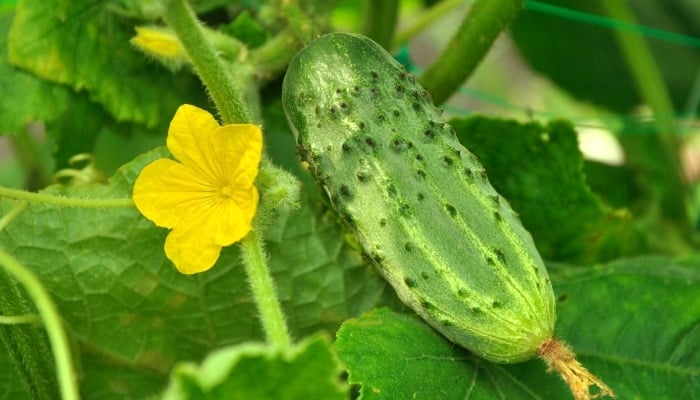
Insects already love plants in this family, so it’s a sure bet that cucurbits will continue to attract them away from your other crops.
Chances are you won’t get any food if you use it as a trap crop, but it will keep your other squash safe!
- Pests Targeted: Squash beetles, cucumber beetles
- Used To Protect: Squash, zucchini
- Where To Plant: Intercrop
12. Dill

Dill is a great garden herb for its fresh flavor, and hornworms and slugs will be all over it! Plant it as a crop, but expect it to be eaten if you have a pest issue.
Sometimes you’ll grow a trap crop you didn’t originally intend to! As a bonus, dill is great for attracting swallowtail butterflies to your garden.
Dill can grow to be around 4 feet tall, so plant it where it won’t shade out your other plants.
- Pests Targeted: Tomato hornworms, slugs
- Used To Protect: Tomatoes
- Where To Plant: Row intercrop
13. Four O’Clocks

This tender perennial is a beautiful multicolored flowering species that doesn’t do well in the cold but will do wonders for your garden with its beauty and bug-attracting ability.
Plant it as an ornamental around and between your vegetables for the best results.
- Pest Targeted: Beetles
- Used To Protect: Vegetables and ornamentals
- Where To Plant: Intercrop
14. Horseradish

This deep-rooted vegetable is great for attracting pests and will grow back year after year. If the plant has the opportunity to produce a large root, dig it up, and use it! It makes a great horseradish dip while defending your garden!
- Pest Targeted: Colorado potato beetles
- Used To Protect: Potatoes
- Where To Plant: Intercrop
15. Legumes

Simply put, legumes are plants that produce bean pods. They’re great trap crops for their sweet leaves and are also great nitrogen-fixing plants.
They help feed your other garden plants by putting nitrogen into the soil.
- Pests Targeted: Leafhoppers, leaf beetles, stalk borers, fall armyworms
- Used To Protect: Corn
- Where To Plant: Row intercrop
16. Marigold

The summer and fall seasons are known for their beautiful colored marigolds (Learn more about them here). Look into the variety you’re growing because these little pom-pom-shaped flowers grow in small and large varieties.
They’ll attract and repel pests and also bring beneficial insects to your garden for defense.
- Pests Targeted: Thrips, Japanese beetles
- Used To Protect: Garlic, brassicas
- Where To Plant: Border Crops, intercrop
17. Medick
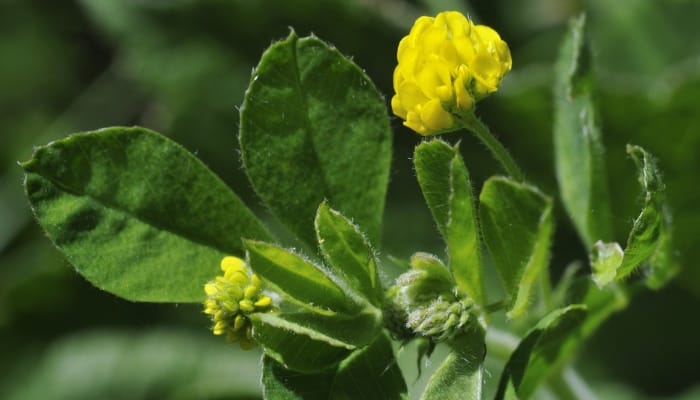
Usually found growing as a common weed, this member of the Fabaceae family will fix nitrogen in the soil for the benefit of other plants.
Not only that but the carrot rust fly will be so attracted to it that you’ll easily be able to decrease their population and save your carrots!
- Pest Targeted: Carrot rust fly
- Used To Protect: Carrots
- Where To Plant: Strip intercrop or between carrot plantings
18. Millet

This naturally gluten-free grain is great to grow for that reason alone, but it is also great at protecting your squash crops!
It will grow and mature much more quickly than your squash, so be sure to succession plant it.
- Pests Targeted: Squash beetles, grasshoppers, midges, thrips, hairy caterpillars
- Used To Protect: Squash
- Where To Plant: Border rows
19. Mustard Plants

Many pests love mustard greens and are easily attracted to them. Indian mustard is a tried-and-true variety that will be sure to keep your brassicas safe.
Most mustards will do the trick, but when they flower, they attract the most pests, so don’t pull them too early!
- Pests Targeted: Cabbage webworms, flea hoppers, mustard aphids, diamondback moths, aphids, flea beetles, grasshoppers
- Used To Protect: All brassicas
- Where To Plant: Row intercrop
20. Napier Grass

If you’re growing in nutrient-void soil, this is a great option! Napier grass has little nutrient and water needs, so it can be used to help build barren soils.
Paired with its trap crop abilities, it’s an easy addition to any garden for full benefits.
- Pest Targeted: Stemborers
- Used To Protect: Corn
- Where To Plant: Border crop or Intercrop
21. Nasturtiums

Nasturtiums are beautiful orange flowering vines, and the flowers are great as traps and also great added to a salad when not covered in pests!
Just beware that once you plant them, they will be difficult to eliminate from your garden.
- Pests Targeted: Aphids, flea Beetles, cucumber beetles, squash vine borers, leafhoppers, cabbage worms, whiteflies, spider mites, flea beetles
- Used To Protect: Cabbage
- Where To Plant: Row intercrop
22. Okra

This woody perennial is most often grown as an annual in cooler climate zones. Plenty of the pests it attracts will eat the leaves, but you should still get some okra to enjoy when the season ends!
- Pests Targeted: Flower cotton weevils, caterpillars, stink bugs, corn earworms, ants, beetles, leaf-footed bugs, spiders
- Used To Protect: Cotton
- Where To Plant: Border crop
23. Onions & Garlic

These long-growing crops will attract several destructive insects to keep pests away from other crops. Garlic in particular is great to have in your garden because its growing season extends for 9 months, while onions mature in 4 months.
You only need to plant them once in a season to have them defend the plants you want to keep safe.
- Pest Targeted: Carrot root fly, thrips
- Used To Protect: Carrots
- Where To Plant: Border crop
24. Parsley

An Italian and French cooking staple, parsley can self-seed easily if allowed to stay in the ground over winter.
Parsley works by attracting hoverflies that prey on aphids, and once it is around it will continue defending your crops.
- Pest Targeted: Aphids
- Used To Protect: Tomatoes
- Where To Plant: Border Rows
25. Radishes

Radish is a very quick-growing crop, and you’ll be able to harvest a few sets of radish before your main crop matures in most cases. Be sure to succession sow these to keep your crops defended.
- Pests Targeted: Flea beetles, root maggots, cutworms, flea beetles, harlequin bugs, aphids, cabbage maggots
- Used To Protect: Cabbage family
- Where To Plant: Row intercrop
26. Sorghum

Sorghum is a grain that is not as common as a flower but is packed with nutrients and can be used in a variety of ways. Outside of the kitchen, sorghum helps protect your corn from a variety of pests.
Chop it down at the end of the season, and till it into the soil to help build the nutrient levels.
- Pest Targeted: Stemborers, armyworms, corn earworms, white grubs, sugarcane borers, corn aphids
- Used To Protect: Corn
- Where To Plant: Border crop or intercrop
27. Soybeans

Part of the legume family, soybeans are great nitrogen-fixing plants as well as pest traps. Pick beans when the pods begin to turn yellow as this is when they are most tender and tasty!
- Pest Targeted: Heliothis spp.
- Used To Protect: Corn
- Where To Plant: Row intercrop
28. Stinging Nettles

While you’ll want to be sure you steer clear of ever touching stinging nettles with your bare hands, they’ll deter pests just as quickly as they deter humans!
Stinging nettles are a great beneficial insect attractant as well.
- Pest Targeted: Aphids
- Used To Protect: Vegetables
- Where To Plant: Intecrop
29. Sunflowers
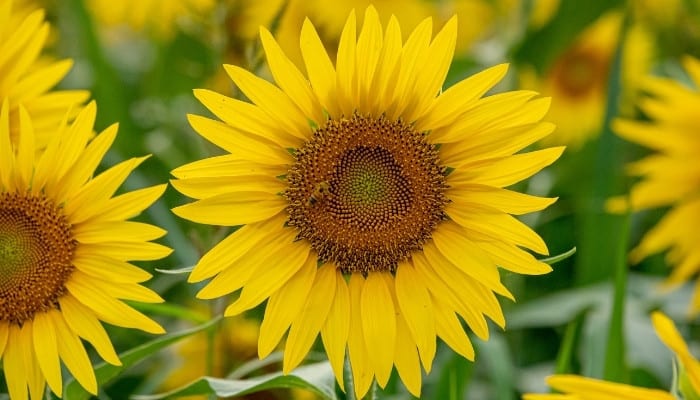
Be sure you have the space to grow these! On the small side, you’ll find varieties that grow to be between 4 and 5 feet, but on the tall side, you’ll get stalks over 8 feet easily!
They’ll attract insects and birds to eat the seeds and pests.
- Pests Targeted: Heliothis spp., weevils, wireworms, earwigs, snails, cutworms
- Used To Protect: Cotton
- Where To Plant: Row intercrop
30. Tansy

Tansy is a unique flowering herbaceous perennial that has flowers with a beautiful bright yellow color and delicate fern-like leaves.
Just be sure not to ingest or touch a leaf with bare hands because it is toxic and an irritant.
- Pests Targeted: Colorado potato beetles, ragwort seed flies, tansy beetles, cinnabar moths
- Used To Protect: Potatoes
- Where To Plant: Intercrop
31. Tomato

Everyone loves fresh summer tomatoes, but in this case, they’re grown to protect cabbage rather than produce fruit.
Be sure to plant them without shading your crop too much as they can grow tall and dense enough to be heavy shade producers.
- Pest Targeted: Diamondback moths
- Used To Protect: Cabbage
- Where To Plant: Intercrop
32. Zinnia

Zinnias are a garden favorite because they grow in a beautiful variety of colors, shapes, and sizes! They are great at attracting beneficial insects as well as trapping the pests listed below.
- Pests Targeted: Japanese beetles, aphids, thrips, beetles caterpillars, spider mites, scales
- Used To Protect: Roses
- Where To Plant: Intercrop
Benefits of Trap Cropping
Using trap crops in your garden has many benefits and is a great option for organic gardening because it will reduce the need for pesticide use, both natural and synthetic.
Many times the trap plant will not only attract pests but also attract beneficial insects to combat the garden pests.
Most varieties can also be grown as a cover crop to enrich the soil when incorporated after it is grown. And of course one of the key benefits is your saved crops!
How To Use Trap Crops for Pest Control
This depends heavily on what main crop you’re planting and what trap crop you’ll want to plant alongside it. See the list below for great tips to maximize what your trap crop can do!
- You’ll want to plant your trap crop in beneficial areas near your main crop, but be sure to give each variety enough space to grow.
- Look at the maturation date of your trap crop and main crop to determine if they should be started at the same time or if the trap crop needs to be started earlier than your main crop so they mature around the same time.
- Think about the pest you’re trying to capture, and plant accordingly. Do the pests come from the ground and climb upward? Or do they fly in from outside of your garden? This will help determine where trap crops should be planted.
- Plan to monitor your trap crops daily until you understand when they are most beneficial. When they are covered in insects, they’re working the best and you’ll know you have a successful trap crop! That is a great time to remove the bugs or plants to kill as many pests as possible.
Considerations Before Planting Trap Crops
You’ll want to keep these considerations in mind when planning your garden and using trap crops:
- If you’ve had pests in the past, you’ll have great insight into specific pests you need to defend against.
- When planning your garden, leave some space for the trap crops to be planted in and around your vegetable crops.
- Take a look at the maturation of your cultivated crops versus your trap crops. If you plant them at the incorrect time, your main crop will mature before your trap crop, making the trap crop planting useless.
- Make use of companion planting by planting attractant crops to lure beneficial insects to the area. Wildflowers are great for attracting beneficial insects such as ladybugs that naturally prey on aphids and other small insects. They’ll do the dirty work of defending your garden!
Options for Killing Pests Once on Trap Crops
Many times your trap crop will only keep the pest distracted, but you’ll need to finish the task at hand of fully removing the insects from the area.
There are a few options when it comes to this. You can use a pesticide (synthetic or natural), or if the pest is large enough, shake it off into a bucket of soapy water or rubbing alcohol to kill it.
Synthetic Pesticides
Synthetic pesticides are not the best for the environment and can not be used in organic gardening. However, sometimes the infestation is extreme, and organic remedies are not strong enough.
This is when synthetic pesticides like Sevin and Bonide come best into play to eliminate the destructive insects.
Natural Pesticides
Natural pesticides are usually allowed in organic gardening and are often necessary if you expect to get any harvest.
Products like neem oil or B.T. are great at preventing pests and killing them after they arrive.

